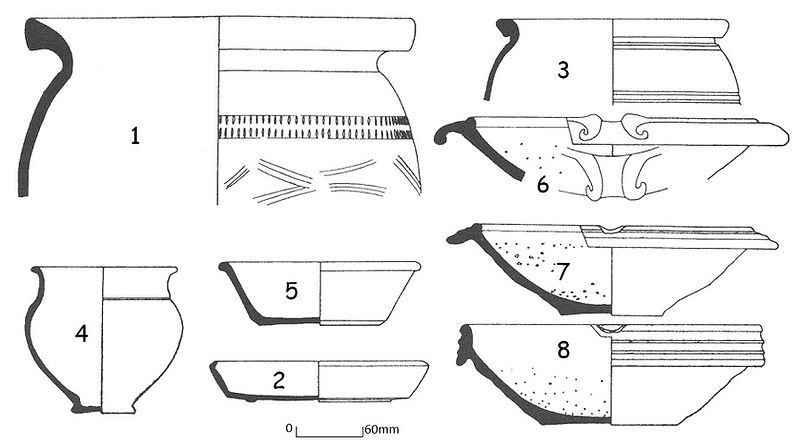Nene Valley Grey Ware
The Nene Valley was an area of pottery production from before the Roman conquest and by the mid first century a variety of course grey wares were being produced. Whilst the area came to specialise in colour coated wares from the mid second century, production of grey wares continued alongside.

Nene Valley grey ware from Stonea (with one obvious exception). © British Museum.
Grey wares were widely produced making up 80% of all Roman pottery found in Britain. They were typically fired to a high temperature and used as cooking vessels, cups and plates. They would be intended primarily for local markets.
The most common form of Nene Valley grey ware was a wide mouthed vessel (type 4 below) which appears to have been a standard form of cooking pot and storage jar for the area. Also commonly found are straight sided dishes and bowls (type 5 below), with or without a triangular rim.

Common forms of grey ware (after Hartley, Notes on the Roman Pottery Industry in the Nene Valley, 1972)
Differences in the form of Romano British grey ware may reflect potters’ preferences rather than be a reliable guide to chronological trends. However, there are clues available when it comes to deducing approximate dates:
-
Rustication (clay drawn up from body or slip in lumps or spidery ridges): AD 50 to 100/120
-
Reeded rim bowl (early military type): AD 60 to 130
-
Barbotine dots with rings: AD 70 to 150
-
Straight-sided dish with triangular rim (dog-dish or pie-dish): AD100-175
[Rim tends to be rounded after this date] -
Burnished lattice covering wide area of body: AD 120 to 250
-
Wavy line decoration: AD 150 to 200
-
Flanged bowl: AD 150 to 250
-
Highly lustrous ‘metallic’ burnish in wide zones: AD 250 to 400
-
Straight-sided flanged dish: AD 250 to 400
-
Burnished lines in large loops, on jars and bowls: 3rd and 4th centuries
After Alice Lyons, Jigsaw - Roman Pottery Identification
